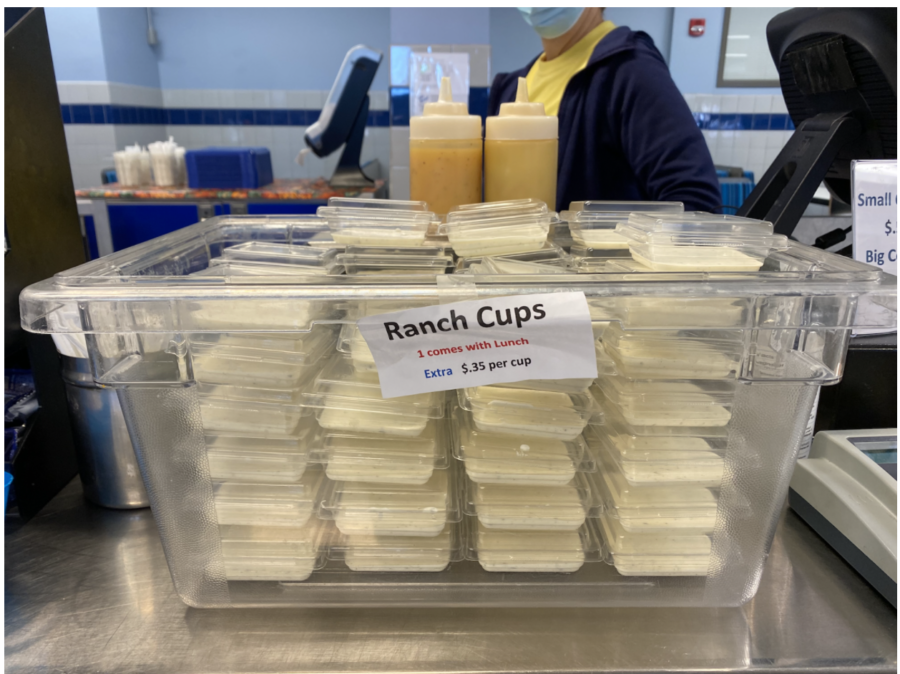Supply Chain shortages hit Highlands High School Ranch
Because of supply chain shortages and rising costs, HHS ranch is now available in cups for students and staff.
Walking into the cafeteria at HHS, students are accustomed to grabbing their Tender Tuesday nuggets and getting ready to pour out the homemade, famous ranch to enjoy.
However, students will find that it is not so easy to do that now.
Now, there is a limit. Every student now receives a free cup of the ranch, but it is $0.35 for every extra cup.
The homemade ranch is expensive, although students are putting more ranch onto their plate than they will actually eat.
Ranch is an important factor in many students’ everyday lunches. While the prices go up, the usage goes down.
A little known fact is that ranch at Fort Thomas Independent Schools is homemade and freshly made every week. At HHS, students go through a large amount of ranch.
FTIS Director of Food and Nutrition Gina Sawma stated, “[The amount of ranch produced] depends on the menu for that week, [but it is] normally four to eight gallons.”
The issue with making this much ranch is the fact that it gets very expensive for the HHS cafeteria. It gets quite expensive to make weekly for students who throw most of it away.
Sawma said, “Eight to ten gallons costs $84.52 to $105.65.”
Buying cases of buttermilk and ranch mix just for a week’s worth of ranch is enough to make the food services program lose money instead of gaining any even with the prices of ranch going up.
It didn’t take long to realize that the ranch was being thrown away.
“We’ve always known. We see the puddles of ranch on trays.”
To try to save money, students now get one cup of ranch free and have to pay an extra $0.35 for each additional cup.
However, this is not enough to make up the loss in income for the food service program according to Sawma.
“The only time we make money is when students buy snacks and drinks.”
At one point, the cafeteria couldn’t even get Gatorade because of the supply chain.
Sawma has to now do a two-week menu instead of a one-month one since the food companies are on backorder.
According to Sawma, she hopes that the other prices of food items will not go up.
Since the school had to buy cases of lettuce, the cost of the salad bar has changed as well.
It’s very difficult to get certain food items that sometimes Sawma ordered in June but it didn’t show up until November.
“I ordered [lunch] trays for Johnson in June and it is now November.”
The struggle with finding food for students, trays for use, and silverware for food have been such a large issue.
Unfortunately, students are unaware of these issues.
Sophomore Robert Moore stated, “I did not know that the prices of ranch went up.”
With the increase of ranch, hopefully, less ranch will be thrown away. With the cups, students won’t pour on their trays and instead get a set amount.
“I use all the ranch,” stated Freshman Mollie Spears.
Luckily with students like Spears, the ranch is being fully used by some students.
Other students, like Britton Bauer, “don’t use the ranch at all” and are upset by the situation.
“I think it’s very upsetting.”
However, other schools around Kentucky are also facing an issue with the supply chain for school lunches.
According to Spectrum News, in Georgetown, Kentucky, Scott County Schools are one among many districts that are facing this problem.
One particular item is milk. Milk is a missing factor in the supply chain. With different organizations trying to get some, it is running low and hard to get for schools.
Mitzi Marshall, Director of Nutrition Services at Scott County Schools, stated that milk is one of the hardest things to get.
“We were having trouble getting through to distribution.”
In HHS, all of the food does not get eaten when it is put on the students; tray. However, it is not so much the distribution, it is the lack of people eating all of the food when they put it on the tray.
Sawma said, “We are not trying to nickel and dime our students. We would like for you to eat what you take.”
Your donation will support the student journalists of Highlands High School. Your contribution will allow us to cover our annual website hosting costs.



